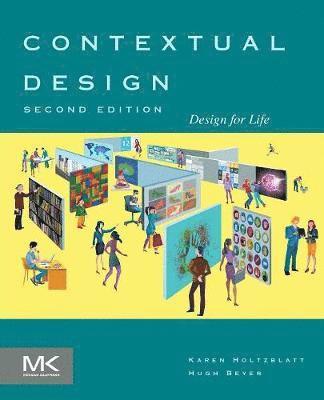
- Format
- Häftad (Paperback / softback)
- Språk
- Engelska
- Serie
- Interactive Technologies
- Antal sidor
- 530
- Utgivningsdatum
- 2016-12-15
- Upplaga
- 2
- Förlag
- Elsevier Science & Technology
- Medarbetare
- Beyer, Hugh
- Dimensioner
- 234 x 190 x 30 mm
- Vikt
- Antal komponenter
- 1
- ISBN
- 9780128008942
- 1112 g
Contextual Design
Design for Life
- Skickas från oss inom 7-10 vardagar.
- Fri frakt över 249 kr för privatkunder i Sverige.
Passar bra ihop
De som köpt den här boken har ofta också köpt Careless People av Sarah Wynn-Williams (häftad).
Köp båda 2 för 1004 krKundrecensioner
Fler böcker av författarna
-
Retaining Women in Tech
Karen Holtzblatt, Nicola Marsden
For over 40 years, the tech industry has been working to attract more women. Yet, women continue to be underrepresented in technology jobs compared to other professions. Worse, once hired, women leave the field mid-career twice as often as men. In...
-
User-Centered Agile Methods
Hugh Beyer
With the introduction and popularization of Agile methods of software development, existing relationships and working agreements between user experience groups and developers are being disrupted. Agile methods introduce new concepts: the Product O...
Övrig information
Karen Holtzblatt is a co-founder of InContext Enterprises, Inc., a firm that works with companies, coaching teams to design products, product strategies, and information systems from customer data. Karen Holtzblatt developed the Contextual Inquiry field data gathering technique that forms the core of Contextual Design and is now taught and used world-wide. Hugh Beyer is a co-founder of InContext Enterprises, Inc., a firm that works with companies, coaching teams to design products, product strategies, and information systems from customer data. Hugh Beyer has pioneered the link between the customer-centered front end and object-oriented design.
Innehållsförteckning
Part 1. Gathering User Data
1. Introduction
2. User Data Drives Design
3. Principles of Contextual Inquiry
4. The Interpretation Session
Part 2. Revealing the World
5. From Data to Insight: Contextual Design Models
6. The Affinity Diagram
7. Building Experience Models
8. Traditional Contextual Design Models
Part 3. Reinventing Life: Ideation with User Data
9. Inventing the Next Product Concept
10. The Bridge From Data to Design: The Wall Walk
11. Ideation: Visioning and the Cool Drilldown
Part 4. Defining the Product
12. The Challenge of Product Design
13. Storyboards
14. The User Environment Design
15. Interaction Patterns
Part 5. Making It Real
16. Making It Real
17. Validating the Design
18. Prioritization and Rollout
19. Project Planning and Execution
20. Conclusion
Du kanske gillar
-
Deep Utopia
Nick Bostrom
Häftad -
AI Con
Emily M Bender, Alex Hanna
Inbunden -
My Next Breath
Jeremy Renner
Häftad -
Careless People
Sarah Wynn-Williams
Inbunden -
Doppelganger
Naomi Klein
Häftad


